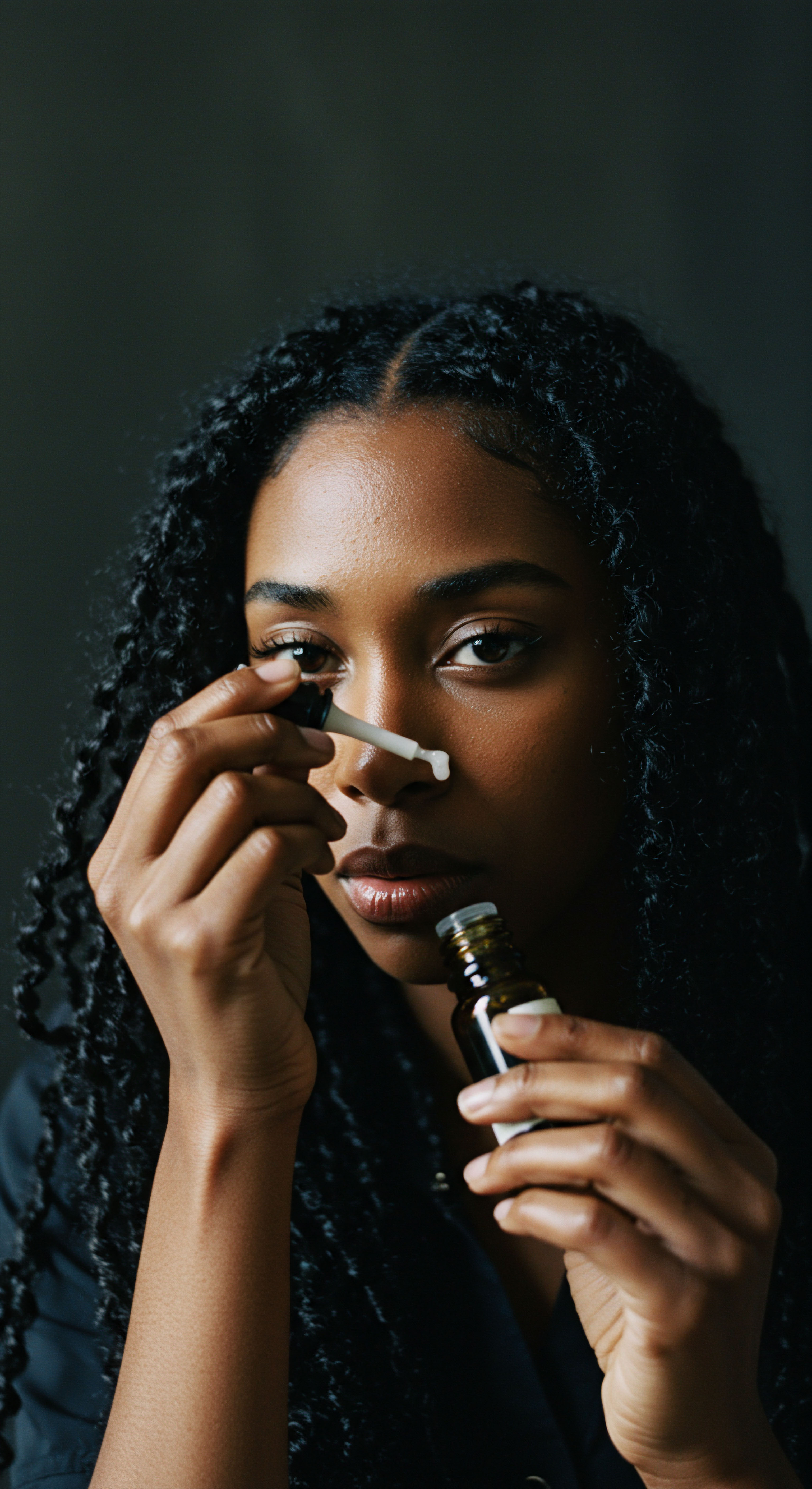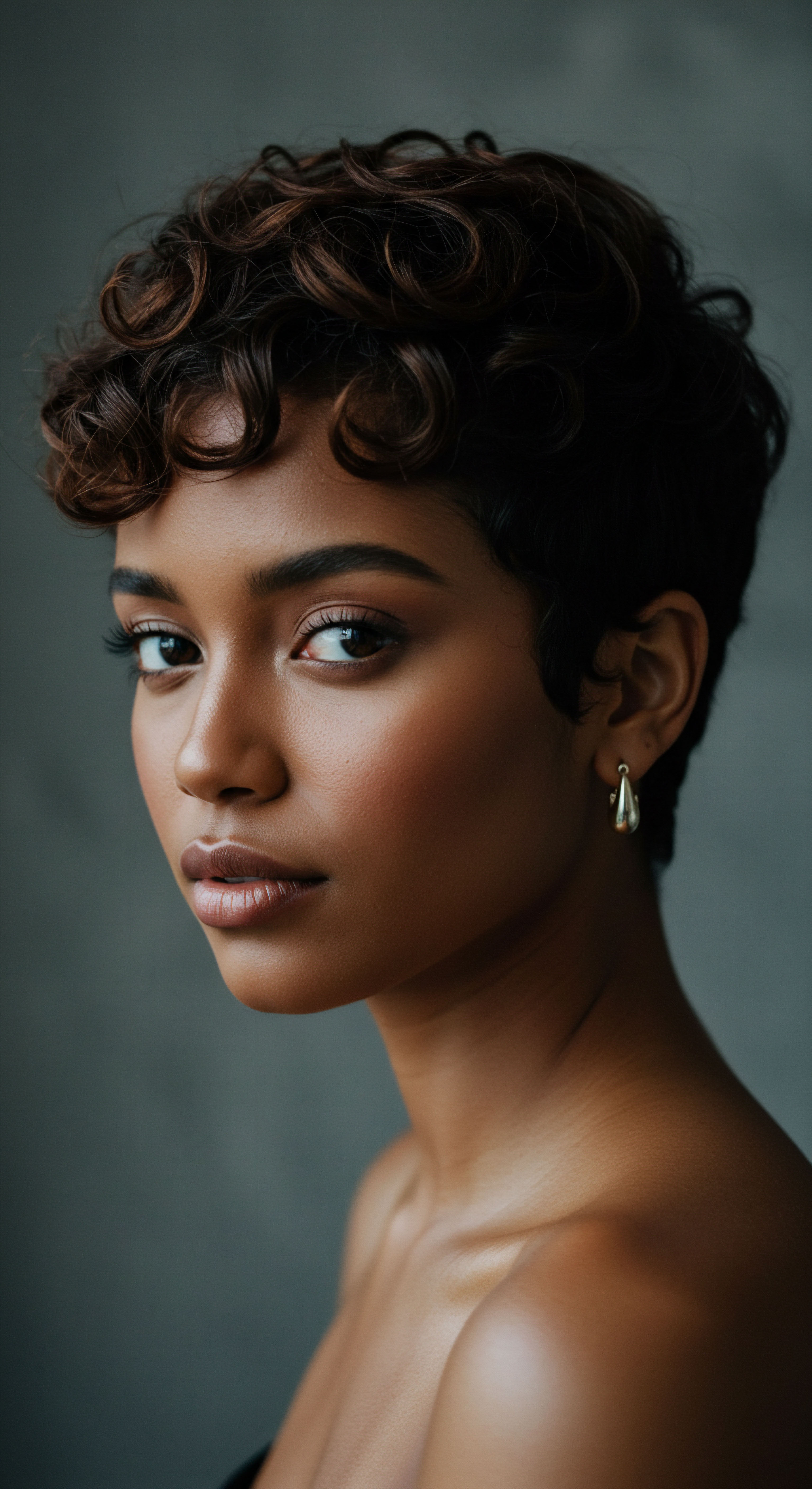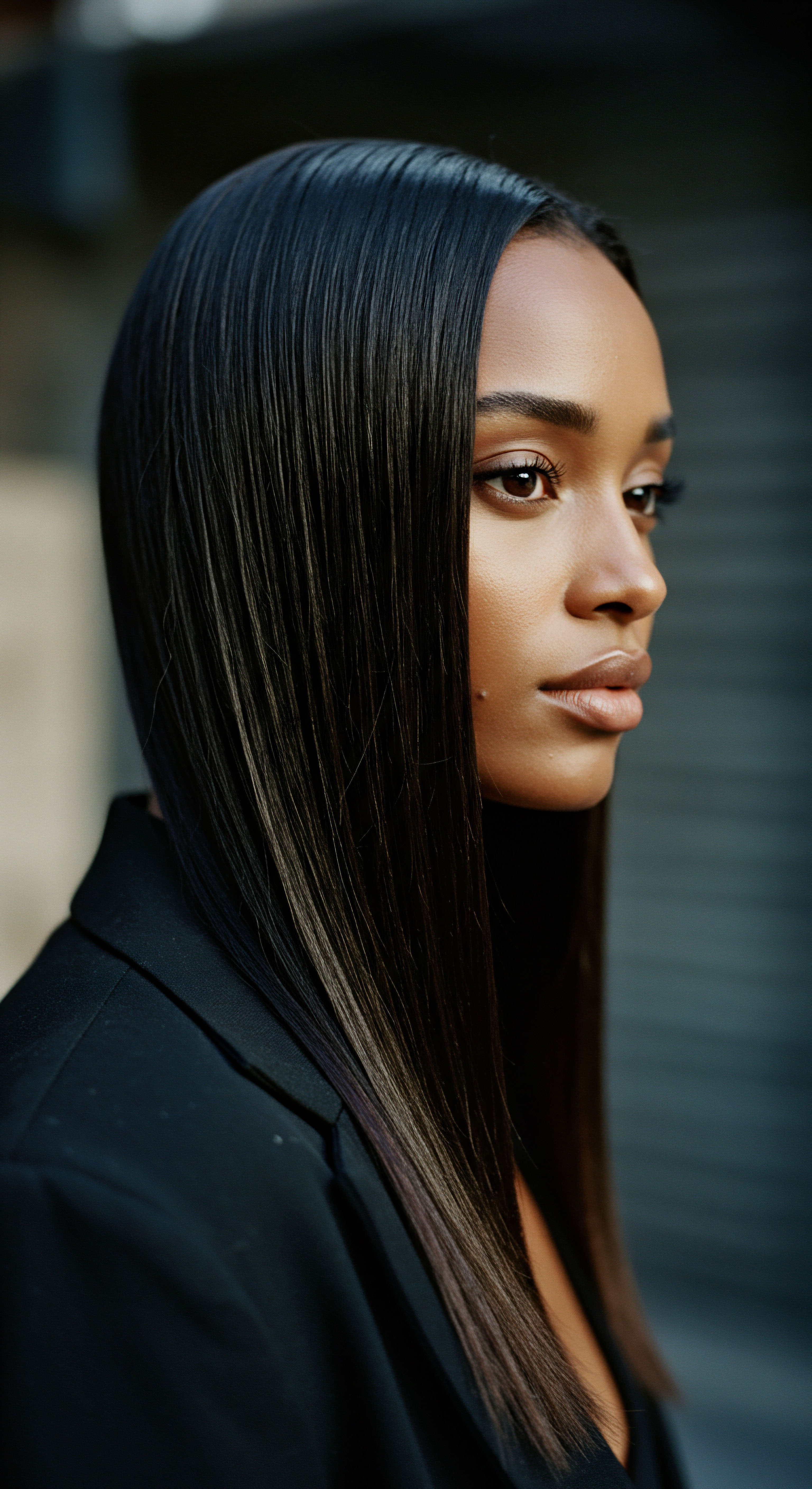
Roots
The quiet rustle of fabric, the gentle drape of a scarf around the crown – for Black hair care, these simple gestures hold layers of meaning that extend far beyond mere adornment. They speak of ancient customs, of ingenious protection, and of enduring statements made in the face of immense challenge. To truly grasp the significance of hair coverings, one must first look to the deep soil of history, to the traditions that predate the transatlantic crossing and continue to shape practices today. This foundational understanding reveals how the very act of covering one’s hair became intertwined with identity, status, and survival.

Pre-Colonial Origins of Hair Covering
Across various regions of pre-colonial Africa, hair was seldom just a physical attribute. It served as a powerful visual language, communicating a person’s identity, marital status, age, social standing, religious affiliation, and even wealth. Intricate braided styles, often adorned with beads, shells, and cloth, were not simply decorative; they were rich symbols, meticulously crafted over hours or even days. The practice of covering hair in these societies was often linked to reverence, modesty, or ceremonial rites.
For example, among the Yoruba, elaborate headwraps, known as “geles,” conveyed high status, their complexity reflecting the wearer’s position. In East Africa, “dhoop” or “leso” headscarves, often featuring bold patterns, symbolized wisdom and strength. Women from Sudan to the Democratic Republic of the Congo used wraps to shield their hair from the sun while affirming their cultural identity.
In pre-colonial Africa, hair coverings were a visual language, communicating identity, status, and spiritual connection through their varied forms.
The act of wrapping hair, therefore, was deeply integrated into daily life and spiritual practice. It was a communal activity, often involving family and friends, reinforcing social bonds during the long hours of styling. The materials used, from natural butters and herbs for conditioning to specific fabrics, were chosen for both their protective qualities and their symbolic value. These practices ensured the health of the hair and scalp, shielding delicate strands from environmental elements like sun and dust, while simultaneously acting as outward expressions of inner worlds.

The Dislocation and Reaffirmation of Hair Identity
The brutal reality of the transatlantic slave trade brought an abrupt and devastating disruption to these deeply rooted traditions. Enslaved Africans were stripped of their cultural tools and accessories, often having their heads shaved as a deliberate act of dehumanization and erasure of identity. Yet, even under such horrific conditions, the spirit of hair care and self-expression found ways to persist. Head coverings, initially enforced by slave owners for reasons of control, hygiene, or to mark social inferiority, began to transform.
What was intended as a badge of servitude became, for many, a covert canvas of resistance and communal identity. Simple head rags, worn by millions, evolved into powerful symbols. Enslaved women, laboring in fields, used headwraps to protect their hair and scalps from the harsh sun, sweat, and grime.
Those who worked in the “big house” might have been compelled to mimic European hairstyles or wear wigs, but the underlying cultural memory of hair’s significance remained. This resilience speaks volumes about the enduring human spirit and the intrinsic value placed on hair as a part of self.

How Did Enslavement Alter Hair Care Traditions?
The forced journey across the Atlantic fundamentally reshaped Black hair care. With limited access to traditional tools, products, or the communal time for elaborate styling, enslaved individuals adapted. Head coverings became a practical necessity for protection against the elements and unsanitary conditions. They shielded hair from dust, lice, and the harsh sun, which could cause damage and breakage.
- Protection ❉ Head coverings offered a barrier against environmental damage, preserving hair health in demanding conditions.
- Hygiene ❉ They helped manage hair cleanliness in environments where proper washing was often difficult or impossible.
- Covert Communication ❉ In some instances, the specific folds or styles of headscarves were used to send coded messages among enslaved people, unknown to their captors.
The very act of covering hair, even when mandated, became a subtle act of defiance, a way to maintain a semblance of personal dignity and cultural connection in an oppressive system. This adaptation highlights the profound resilience of Black communities in preserving elements of their heritage despite concerted efforts to suppress them.

Ritual
Stepping from the deep historical ground, we arrive at the living practices that continue to shape Black hair care today, where hair coverings play a significant role. This section explores the daily and periodic customs that transform a simple piece of fabric into a vital component of hair health, preservation, and self-expression. It is a space where practical wisdom meets personal care, guided by an understanding of how these rituals support the unique needs of textured hair.

The Nighttime Sanctuary
One of the most widespread and personally meaningful uses of hair coverings in contemporary Black hair care is the nighttime ritual. The silk bonnet or scarf is not merely an accessory; it is a shield, a guardian for strands against the friction and moisture-stripping effects of cotton pillowcases. This practice is passed down through generations, almost a quiet rite of passage. The gentle glide of silk or satin against the hair helps to retain precious moisture, reduce tangling, and preserve styled hair, extending the life of protective styles like braids, twists, or straightened hair.
Nighttime hair coverings protect textured hair from friction and moisture loss, acting as essential guardians for delicate strands.
The deliberate act of wrapping hair before sleep speaks to a deeper care, a recognition of hair’s vulnerability and its need for thoughtful attention. This simple routine helps Black women wake with hair that feels nurtured, which in turn can contribute to a feeling of confidence throughout the day. The care given at night provides a peaceful foundation for the day’s appearance, reducing morning styling time and minimizing potential damage.

Protection Beyond Sleep
Beyond the quiet of the night, hair coverings serve numerous protective functions in daily life. Headwraps shield hair from environmental aggressors such as sun, wind, and pollution, which can dry out strands and diminish their vibrancy. For those who engage in activities that involve sweat or dust, a covering provides a practical barrier, keeping hair clean and neat. This is particularly relevant for active lifestyles, where the desire to maintain hair health can sometimes conflict with exercise habits.
Some studies, for instance, have indicated that a notable percentage of Black women report avoiding exercise due to hair care concerns, highlighting the need for protective measures that allow for both activity and hair preservation. Head coverings provide a solution, allowing for physical activity without compromising hair integrity.
Moreover, head coverings offer a convenient solution for “bad hair days” or during hair transitions, allowing for quick styling and a polished appearance without resorting to heat or excessive manipulation. They become a canvas for personal style, with a vast array of colors, patterns, and tying techniques allowing for individual expression.

What Practical Benefits Do Hair Coverings Offer for Daily Hair Care?
The utility of hair coverings extends into many facets of daily hair management, providing tangible benefits that support the health and appearance of textured hair. These benefits stem from the unique structure of Black hair, which tends to be more prone to dryness and breakage due to its coily nature.
- Moisture Retention ❉ Materials like silk and satin, commonly used for bonnets and scarves, create a smooth surface that reduces friction and helps hair retain its natural oils and applied moisture. This is crucial for preventing dryness and maintaining elasticity.
- Reduced Friction and Breakage ❉ Cotton, often found in pillowcases and clothing, can absorb moisture from hair and cause friction, leading to frizz, tangles, and breakage. Hair coverings provide a protective layer, minimizing this abrasive contact.
- Style Preservation ❉ Wrapping hair at night or during activities helps to keep styles intact, whether it’s a freshly done twist-out, braids, or straightened hair. This reduces the need for daily restyling, which in turn minimizes heat exposure and manipulation.
These practical advantages underscore the enduring relevance of hair coverings as a fundamental tool in the regimen of textured hair care, allowing individuals to maintain hair health and versatility with greater ease.
| Material Silk |
| Primary Benefit Reduces friction, retains moisture |
| Use Context Nighttime, delicate styles |
| Material Satin |
| Primary Benefit Smooth surface, affordable alternative to silk |
| Use Context Nighttime, daily wear |
| Material Cotton Blends |
| Primary Benefit Breathable, absorbent (less ideal for moisture retention) |
| Use Context Fashion, general protection (often lined with silk/satin) |
| Material African Wax Print |
| Primary Benefit Cultural expression, aesthetic appeal |
| Use Context Fashion, cultural events |
| Material Each material offers distinct advantages for different hair care needs and occasions. |

Relay
Moving beyond the practical and personal, the historical significance of hair coverings for Black hair care extends into a complex interplay of cultural defiance, social commentary, and a continuing reclamation of identity. This deeper exploration unearths the layers of meaning embedded in these coverings, revealing how they have served as powerful instruments in ongoing struggles for recognition and respect.

The Tignon Laws A Case Study in Defiance
One of the most striking historical instances of hair coverings as a tool of both oppression and resistance is the implementation of the Tignon Laws in Louisiana in 1786. Spanish Governor Esteban Rodríguez Miró mandated that free women of color wear a tignon, a headscarf, over their hair. The intention was clear ❉ to visibly mark these women as belonging to a lower social status, separate from white women, and to suppress their perceived beauty and allure that had captivated white men. This law aimed to diminish their social standing and control their public presentation.
However, the women targeted by these laws, far from being subdued, responded with remarkable creativity and ingenuity. They transformed the mandated tignon into a bold statement of style and resistance. They used luxurious fabrics, vibrant colors, and elaborate tying techniques, adorning their headwraps with jewels, ribbons, and feathers. What was meant to be a symbol of subservience became a testament to their resilience, their aesthetic sensibility, and their unwavering spirit.
This act of defiance effectively inverted the oppressive intent of the law, turning a tool of control into a symbol of distinction and pride. The Tignon Laws, though no longer enforced by the early 1800s, stand as a profound historical example of how Black women have consistently reclaimed and redefined imposed symbols, making them their own.

From Oppression to Self-Affirmation
The echoes of the Tignon Laws resonate through centuries of Black hair history. During slavery, hair was often shaved or covered to strip individuals of their cultural ties. Yet, even then, headwraps provided a means of protection and a subtle assertion of self.
Post-slavery, as Black communities sought to assimilate into dominant society, there was often pressure to conform to Eurocentric beauty standards, which included straightening hair. Public wearing of headscarves sometimes became associated with domestic work or a lack of social standing.
The mid-20th century, particularly during the Civil Rights and Black Power movements, witnessed a powerful resurgence of natural hairstyles and head coverings as symbols of racial pride and political consciousness. The Afro, in particular, became a potent statement against Eurocentric beauty norms. Headwraps, too, re-emerged as a deliberate embrace of African heritage, worn with intention and celebration. This period marked a conscious reclaiming of styles once used to shame, transforming them into emblems of self-love and cultural belonging.

What Does the CROWN Act Reveal About the Enduring Struggle for Hair Acceptance?
The ongoing legislative efforts surrounding the CROWN Act (Creating a Respectful and Open World for Natural Hair) in the United States underscore the continued relevance of hair coverings and natural hairstyles as sites of social and racial contention. Despite historical shifts, bias against Black hair persists in schools and workplaces. Studies have revealed that Black women with natural hairstyles are often perceived as less professional or competent, and are less likely to be recommended for job interviews compared to those with straightened hair.
The CROWN Act highlights the contemporary need for legal protection against hair discrimination, a persistent issue rooted in historical biases.
A 2019 CROWN Research Study for Women found that Black women are 1.5 times more likely to be sent home from work because of their hair and 3.5 times more likely to be perceived as ‘unprofessional’ due to their hair. This data point is not just a statistic; it reflects a lived reality where identity and livelihood remain intertwined with hair presentation. The CROWN Act seeks to provide legal protection against such race-based hair discrimination, recognizing that hair textures and protective styles inherent to Black culture are often unfairly targeted by appearance policies. The very necessity of such legislation in the 21st century reveals the deep-seated nature of hair bias, a direct descendant of historical attempts to control and devalue Black identity.
- Systemic Bias ❉ Discriminatory grooming policies in schools and workplaces often reflect Eurocentric beauty standards, labeling natural Black hairstyles as “unprofessional” or “unruly.”
- Economic and Educational Impact ❉ Such policies can lead to disciplinary actions, social ostracization, and even denial of employment or educational opportunities for Black individuals.
- Cultural Affirmation ❉ The fight for the CROWN Act is a continuation of the historical struggle for Black individuals to define their own beauty and identity without penalty.

Beyond the Veil Protection and Power
The historical significance of hair coverings for Black hair care extends beyond overt acts of resistance to encompass quieter, yet equally powerful, assertions of agency and self-care. In many African cultures, hair was considered the most elevated part of the body, sometimes linked to spiritual power and connection to ancestors. Covering the hair, in this context, could be an act of reverence, safeguarding this sacred aspect of self.
In the diaspora, this spiritual and protective dimension continued. Headwraps became a way to shield not only the physical hair but also the wearer’s spiritual and psychological well-being from a hostile world. They provided a sense of personal space, a private realm for the hair and mind, in environments that often offered little privacy or respect. This quiet act of self-preservation, of protecting one’s crown, remains a powerful undercurrent in the practice of hair covering today.
| Historical Period Pre-Colonial Africa |
| Primary Symbolism Status, identity, spirituality, modesty |
| Associated Cultural Movements/Events Traditional ceremonies, daily life |
| Historical Period Slavery Era |
| Primary Symbolism Forced subservience, covert resistance, protection |
| Associated Cultural Movements/Events Plantation life, Tignon Laws |
| Historical Period Post-Slavery to Early 20th Century |
| Primary Symbolism Domesticity, gradual assimilation pressure |
| Associated Cultural Movements/Events Shifts towards Eurocentric beauty norms |
| Historical Period Mid-20th Century (Civil Rights Era) |
| Primary Symbolism Black pride, political statement, cultural reclamation |
| Associated Cultural Movements/Events Black Power Movement, "Black Is Beautiful" |
| Historical Period Contemporary Era |
| Primary Symbolism Self-care, protection, identity, fashion, spiritual connection |
| Associated Cultural Movements/Events Natural Hair Movement, CROWN Act advocacy |
| Historical Period Hair coverings have continuously transformed their meaning, reflecting the dynamic history of Black identity. |

Reflection
The journey through the historical landscape of hair coverings for Black hair care reveals a story far richer and more complex than a simple fashion trend. It is a testament to the enduring spirit of a people, a silent language spoken through fabric and form. From ancient African traditions of status and spiritual connection to the forced coverings of enslavement, and then to the defiant, artistic expressions that subverted oppressive laws, these head coverings have always been more than mere cloth.
They are a profound reflection of identity, a shield against societal pressures, and a vibrant celebration of heritage. In their quiet strength, they continue to remind us that true beauty, and indeed true selfhood, can never be dictated, only affirmed.

References
- Banks, Ingrid. 2000. Hair Matters ❉ Beauty, Power, and Black Women’s Consciousness. New York ❉ New York University Press.
- Byrd, Ayana & Tharps, Lori. 2001. Hair Story ❉ Untangling the Roots. New York ❉ St. Martin’s Press.
- Griebel, Helen Bradley. 1994. The African American Woman’s Headwrap ❉ Unwinding the Symbols. Art, Design, and Visual Thinking.
- Johnson, T. and Bankhead, T. 2014. Hair It Is ❉ Examining the Experiences of Black Women with Natural Hair. Open Journal of Social Sciences, 2, 86-100.
- LoPresti, P. J. Papa, C. M. & Kligman, A. M. 1968. Hot comb alopecia. Archives of Dermatology, 98(3), 234-238.
- Patton, Tracey Owens. 2006. Hey Girl, Am I More Than My Hair? African American Women and Their Struggles with Identity.
- Randle, Brenda A. 2015. I Am Not My Hair; African American Women and their Struggles with Embracing Natural Hair! Race, Gender & Class 22(1/2):114-121.
- Thompson, Cheryl. 2009. Black Women, Beauty, and Hair as a Matter of Being. Journal Women’s Studies 38(8):831-856.
- Weitz, Rose. 2000. Rapunzel’s Daughters ❉ What Women’s Hair Tells Us About Women’s Lives. Farrar, Straus and Giroux.